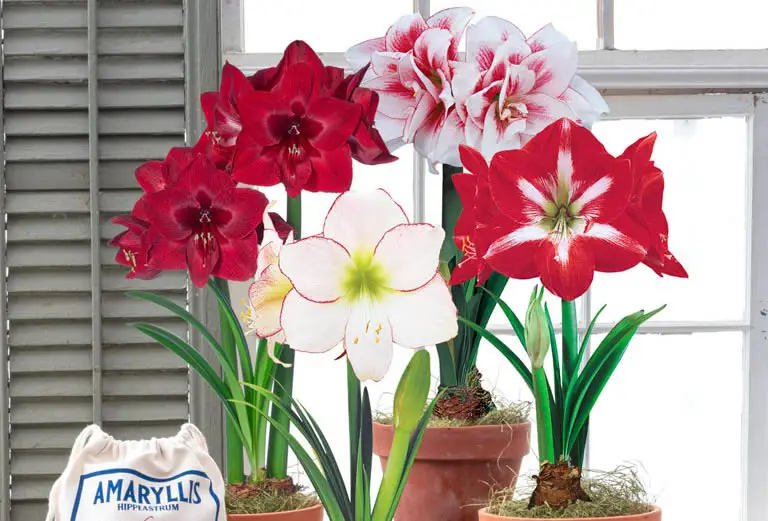Amaryllis is a popular houseplant in America. Being an easy-care succulent amaryllis requires very little attention. but this often leaves many plant owners not knowing what to do with their amaryllis once it has finished blooming.
Table of Contents
- How To Deal With An Amaryllis Bulb After They Blooming Is Completed
How To Deal With An Amaryllis Bulb After They Blooming Is Completed
Unfortunately, many amaryllis owners take the wrong actions and end up damaging their plant.
So, in this article I will show you the exact steps you should take once your amaryllis has finished blooming so it stays healthy and continues to bloom each year for decades.
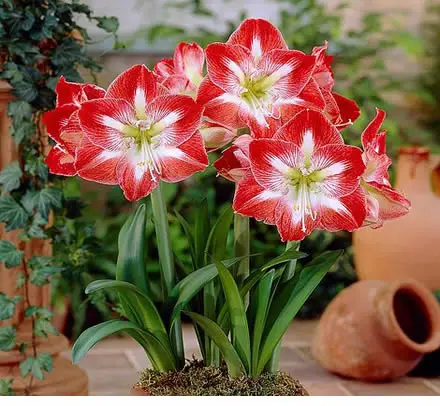
So you’ve been growing an amaryllis successfully and seen your plant produce some gorgeous, vibrant and colorful blooms.
But, now that the plant has finished flowering what should you do with your amaryllis bulb after it has bloomed?
Once amaryllis has finished blooming the bulb must be allowed to go dormant.
An amaryllis bulb does not require darkness to go dormant you can leave it in the pot and in the same place.
Do not water or fertilize amaryllis after it has bloomed, nor should you cut the leaves, as this will cause the bulb to skip dormancy and enter a new growth stage which will deplete and damage the plant.
Amaryllis are perennial succulents. This means if the plant is cared for correctly it will bloom every year.
Part of a proper care routine for amaryllis is allowing the bulb to rest and you must do this after the plant has finished blooming.
It is after each blooming stage has completed that an amaryllis bulb will rest and you must allow this to happen if you want a healthy plant that flowers every year for decades.
Why is this important?
The importance of dormancy to amaryllis
After an amaryllis has finished blooming the bulb will begin to enter a dormancy phase.
This is part of the natural growth cycle of the plant.
You will know that dormancy is starting when you notice the leaves of your amaryllis start to turn yellow at the tips (see this article).
Eventually the entire leaf will turn yellow and fall off the bulb. This will continue will all the foliage on the plant.
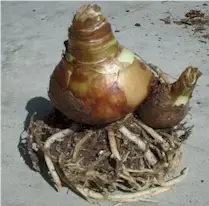
When the bulb is fully dormant there will be no leaves or stalks visible on the bulb at all.
I have found that in the past, (less so these days with the Internet at hand), some amaryllis owners mistakenly think the plant has died when it loses all its leaves and so dispose of the bulb.
Never do this! Your amaryllis is not dead, it is merely resting.
Amaryllis can last decades, and as I pointed out in a previous article about amaryllis bloom times. I know of some amaryllis plants in the US that have been producing yearly blooms since the 1950s.
You see, when an amaryllis loses its stalks and all of its leaves it has merely entered a stage of dormancy.
This is an essential resting phase for the plant where the bulb gathers much-needed resources for its next growth stage.
If you want to understand all the growth stages of the amaryllis read this article.
Well then, what exactly do you need to do with your amaryllis once it has finished flowering and the bulb wants to enter dormancy?
What I do with an amaryllis when it has finished flowering
You should water and fertilize amaryllis regularly throughout its growth stages, especially when it is only starting to bloom.
There are other important and specific things you must do once the plant has finished flowering.
So, how do you care for an amaryllis after it blooms?
When an amaryllis has finished flowering you must allow the bulb to rest.
This means you should stop watering the plant and you should not give it any fertilizer.
Do not cut the leaves off or repot the bulb.
If left alone amaryllis will enter a 2 – 3 month phase of dormancy, after blooming has finished, when the bulb rests and gathers resources.
As I mentioned above it is vitally important to allow an amaryllis bulb to rest if you want to retain a healthy plant that will continue to produce blooms for many years to come.
The good news is that you don’t really need to do anything to allow this to happen.

Having said, there are some very definite things that you should not do when an amaryllis bulb wants to rest.
Firstly, there is no need to move your amaryllis plant after it has finished flowering, and enters dormancy.
The bulb will happily go dormant in the same pot , sitting in same place it has always sat.
However, some owners will move the potted plant, or actually remove the bulb from the pot, and store it in a dry, cool and dimly lit place to prolong the dormancy phase.
Why do they do this and why would you want to consider doing it?
Well amaryllis, as a houseplant, can be made to bloom in any season simply by regulating its growth cycle. Amaryllis has an 8 – 12 week cycle of growth.
When the bulb comes out of dormancy and starts to form new foliage it will go through its growth cycles culminating in full blooms 8 – 12 weeks later.
Once it has finished blooming the bulb will re-enter a state of dormancy for about 2 months before starting the cycle all over again.
By moving an amaryllis to a dimly lit area that is cool and dry you can trigger dormancy or prolonging the dormancy time.
You can then reactivate the bulb whenever you want it to enter a new growth stage simply by reinstating its ideal growth conditions.
Repotting the bulb in fresh soil, giving it a healthy drink of water and moving the pot back to its original well-lit area will trigger new growth.
This will encourage new foliage growth and the amaryllis will begin its 8 – 12 week cycle from first growth to bloom.
Thus you can choose when the amaryllis blooms.
Read this if you want to more detailed instructions for controlling the blooming time of your amaryllis.
Don’t throw away an amaryllis bulb as it can be reused
There is a misconception among some amaryllis owners that the plant will only flower once and then die.
Many amaryllis owners see the bulb lose all of its foliage and do nothing for several months and so wonder if the bulb can be reused or if the plant is actually dead.
An amaryllis bulb can, and should, be reused.
Amaryllis is a perennial, meaning it flowers every year.
An amaryllis bulb will go dormant for a few months after blooming has finished.
It does this so it can rest and gather resources for its next growth stage.
To reuse the bulb you should avoid encouraging new growth at this time and allow the bulb to rest.
An amaryllis bulb, unlike many other plants, does not require darkness in order to go dormant.
Although many amaryllis growers will move their potted plant, (or even take the bulb out of the soil completely), and store it in a dark and dry place, this is not at all necessary with amaryllis.
An amaryllis bulb will happily rest in the same place it bloomed in as long as you do not stimulate new growth.
How can you ensure you don’t do that? Well, I will tell you what I do.
How to keep your amaryllis bulb for next year
Once someone realizes that amaryllis is not a one-time deal and that it will in fact flower year-on-year for many, many years, they wonder what they should do with the bulb once it stops producing foliage.
How do I keep my amaryllis bulb to ensure another healthy bloom next year?
I keep my amaryllis bulb in the same pot that I grow it in after blooming has finished, unless I want to change when the plant blooms.
I always allow the bulb to go dormant for at least 2 months before repotting it.
To change the bloom time I either force the bulb to go dormant or prolong its dormancy until I am ready for it to produce new growth.
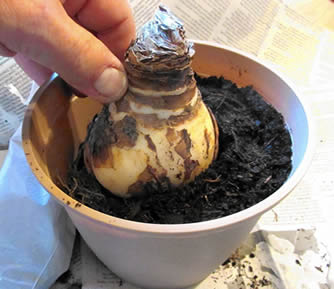
The bulb needs to be moved to do this. Once new growth starts to form I repot the bulb in fresh soil.
If you do not want to change the time of year when your amaryllis blooms then it needs no attention at all after blooming has finished.
When flowering is complete amaryllis will start to enter a dormant phase where the bulb rests and gathers fresh resources for its next growth stage.
At this time the leaves will start to turn yellow and the plant may droop or fall over as the leaves die.
Do not water the plant.
Do not fertilize the plant.
Do not cut off the foliage on the plant though it is fine to remove dead flowers if they look unsightly are are taking away from the ethics of the bloom.
Just be sure not to remove any leaves.
If you want to change the bloom time of your amaryllis, or stagnate amaryllis growth so that as one plant goes dormant another is blooming, I have detailed instructions for that. I give this at the end of this article.
Leaving a dormant amaryllis bulb in its pot is fine
So, can you leave plant bulbs in pots when they go dormant?
All plant bulbs can be left in their pots when the plant enters dormancy.
In the case of amaryllis, the pot will be fine sitting in the same place while the plant rests because the bulb does not need darkness to go dormant.
You must avoid taking actions that will reactivate the bulb during dormancy though.
Once your amaryllis starts to show signs of new growth you should repot it with fresh soil.
It is a good idea to leave an amaryllis bulb in its pot when it goes dormant and just allow it to rest and gather resources.
You should take no action with the plant, i.e. do not water it, feed it or prune it.
You can, if you wish, remove the bulb and store it on some newspaper or kitchen paper in a dimly lit, cool environment if you want to prolong dormancy.
Temperatures of between 55° – 59°F are ideal for this as this range is just below the temperature needed for growth but not cold enough to damage the plant.
You can only leave a dormant amaryllis in the ground in certain USDA climate zones
Although a potted amaryllis is fine staying in the same pot, and the same spot, all year round this may not be the case for yard plants.
Amaryllis can be left in the ground in areas that do not experience winter and early spring frost.
In USDA climate zones 9 through 11 you can leave amaryllis in the ground all year round.
In climate zone 8 the bulb can be left in the ground but will need winter protection.
In all other climate zones it is best to remove the bulb from the ground when summer ends.
Once removed from the ground you should store the amaryllis bulb indoors in a cool and dry location and then replant in late spring/early summer.
Amaryllis is a tropical succulent, and the genus of Amaryllidaceae sold as amaryllis are subtropical, (see this for more information on why some amaryllis plants are not actually amaryllis at all).
This means the plant will react poorly to cold weather conditions.
Frost will kill amaryllis.
Amaryllis grows best in tropical and subtropical temperatures that range between 70° – 90° fahrenheit.
As most homes fall into these temperature ranges in both summer and winter due to HVAC, amaryllis makes the perfect houseplant.
Because the US has only limited tropical and subtropical zones this means most areas of the United States are not suitable for growing amaryllis outdoors – at least not all year round.
Luckily, amaryllis will still grow in temperatures above 60°F making it suitable for summer use outdoors all across America.
I have personally planted amaryllis bulbs in climate zones 7 through 9 and the plants have flourished.
However, I did need to stress to the garden owners that the bulb needed to be removed from the ground as soon as early fall came.
So what do you do with the bulb in the winter?
Storing a bulb removed from the ground is a simple process. Simply remove the bulb from the soil and gently wipe if free from access debris.
Then store in in a dimly lit area, on newspaper or kitchen paper, in cool temperatures preferably between 55° – 59°F.
The bulb will usually stay dormant until you replant it.
If new growth does appear before summer you can place it in a pot with the appropriate type of soil, like this, and keep it indoors until the weather conditions are warm enough for replanting in the yard.
If you want more detailed information about using amaryllis outdoors, both as a potted plant and a yard plant, read my ultimate guide to using amaryllis outside.
The length of time you should let an amaryllis bulb stay dormant
So I have pointed out that an amaryllis absolutely needs to be allowed to rest if you do not want to run the risk of damaging your plant and want to keep it for decades.
But how long does an amaryllis bulb need to be dormant?
An amaryllis bulb needs to be dormant for at least 8 weeks in order to rest and gather resources for its next growth stage.
It is best to allow the bulb to follow its own dormancy cycle, which can last up to 3 months, for the most colorful and healthy blooms.
Although you can force a bulb out of dormancy through artificial measures an amaryllis bulb should always be allowed to rest for at least 2 months.
I always urge amaryllis owners not to mess with the growth cycles of this succulent too much.
If you simply allow amaryllis to do its own thing then the bulb will enter dormancy after blooming has completed and the plant will grow new foliage when it has gathered enough resources.
This leads to a healthy plant with vibrant and colorful blooms every year.
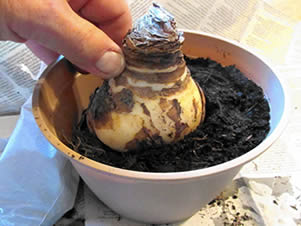
However, there may be times when you want to change when your amaryllis blooms (which is totally possible).
Amaryllis is often called the Christmas Flower or Christmas Plant because many people, and flower sellers, have cultivated amaryllis for a Christmas bloom.
I have amaryllis houseplants that I have cultivated to bloom at Christmas, (instructions for doing that here).
Amaryllis blooms are simply spectacular at Christmas because they add a natural look to existing festive decorations.
A word of advice though, I only ever change the growth and blooming cycle of an amaryllis once (or twice at the most and only with years of an interval).
I do it only once because these succulents can last many decades when they are left to grow at their own pace and in their own time.
Although I have no direct experience of amaryllis being adversely affected by continued forced reblooming, (because I seldom do it), I can make a well-informed and educated guess that It’s mot a good thing to do.
Continually messing with the cycle of the bulb will eventually lead to inferior blooms and will most definitely lessen the life of the bulb. Just do it once and leave it at that.

